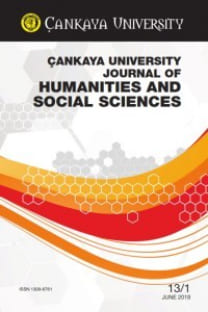Arthur C. Clarke’ın Çocukluğun Sonu Romanında Ruhsal Büyüme
Arthur C. Clarke, çocukluk, büyüme, ruhsal büyüme, Budizm
Spiritual Growth in Arthur C. Clarke’s Childhood’s End
Arthur C. Clarke, childhood, growth, spirituality, Buddhism,
___
- Arnett, Jeffrey. Adolescence and Emerging Adulthood. New York: Pearson, 2012.
- Baldick, Chris. Bildungsroman. In Oxford Concise Dictionary of Literary Terms. Oxford: Oxford University Press, 1990.
- “Breakthrough.” The American Psychological Association. dictionary.apa.org/breakthrough. Accessed 03 Dec. 2020.
- Bond, Lyndal, et al. “Individual, family, school, and community risk and protective factors for depressive symptoms in adolescents: A comparison of risk profiles for substance use and depressive symptoms.” Prevention Science, vol. 6, no. 2, 2005, pp. 73–88.
- Clarke, Arthur. C. Childhood’s End. London: Pan Macmillan, 1990.
- ---. Interview by Free Inquiry. God, Science, and Delusion: A Chat with Arthur C. Clarke, Spring 1999, https://secularhumanism.org/1999/04/god-science-and-delusion/. Accessed 23 Dec. 2020.
- ---. Foreword. The Buddha’s Teachings on Prosperity, by Bhikkhu Basnagoda Rahula, USA: Wisdom Publications, 2008, pp. viii-x.
- Conze, Edward. Buddhism: its essence and development. New York: Harper Torchbooks, 1965.
- Derrida, Jacques. “Structure, Sign and Play in the Discourse of the Human Sciences.” Critical Theory Since 1965, edited by Hazard Adams and Leroy Searle, Tallahassee: Florida State University Press, 1986, pp. 83-94.
- Hull, Elizabeth Anne. “Fire and Ice: The Ironic Imagery in Arthur C. Clarke’s Childhood’s End.” Extrapolation, vol. 24, no. 1, 1983, pp. 13-32.
- ---. “On His Shoulders: Shaw’s Influence on Clarke’s Childhood’s End.” Shaw, vol. 17, 1997, pp. 107-17.
- Huntington, John. “The Unity of Childhood’s End.” Science-Fiction Studies, vol. 1, no. 3, 1974, pp. 154-64.
- Larson, Reed. and Maryse. H. Richards. Divergent Realities: The Emotional Lives of Mothers, Fathers, and Adolescents. New York: Basic Books, 1994.
- Mintz, Steven. The Prime of Life: A History of Modern Adulthood. Cambridge: The Belknap Press, 2015.
- Petersen, A. C., et al. “Depression in Adolescence.” American Psychologist, vol. 48, 1993, pp. 155–68.
- Samuelson, David. N. “Childhood’s End: A Median Stage of Adolescence.” Science-Fiction Studies, vol. 1, no. 1, 1973, pp. 4-17.
- The Dalai Lama. The Four Noble Truths: Fundamentals of the Buddhist Teachings. Translated by Geshe. Thupten Jinpa, edited by Dominique Side, London: Thorsons, 1997.
- ISSN: 1309-6761
- Yayın Aralığı: Yılda 2 Sayı
- Başlangıç: 2004
- Yayıncı: Çankaya Üniversitesi
Flaubert’in Papağanı Romanında Yazar, Otorite ve Özgünlük Arayışı
Mustafa Zeki ÇIRAKLI, Öznur YEMEZ
Arthur C. Clarke’ın Çocukluğun Sonu Romanında Ruhsal Büyüme
Thackeray’in Çocukları: Gülme, Çocukluk ve Peri Masalının Büyü Bozumuna Uğratılışı
And Breathe Normally ve Anchor Baby adlı Filmlerde Afrikalı Göçmen Annelerin Kurgusal Hayatları
Edebiyat Kuramı, Biçimbilim ve Bilişsel Şiirbilim
Julian Barnes’ ın Korkulacak Bir Şey Yok Adlı Eserinde Ölüm ve Ölüm Korkusu
